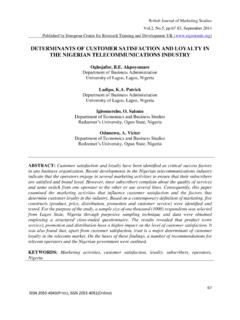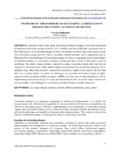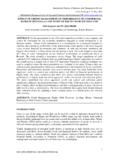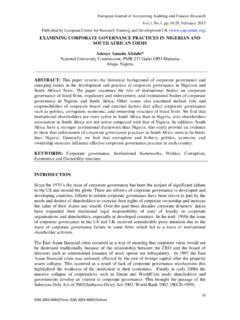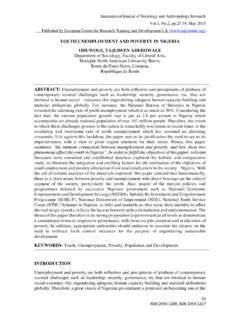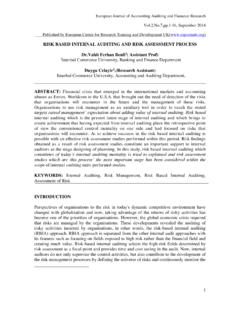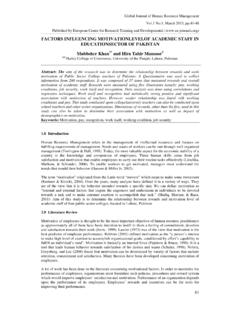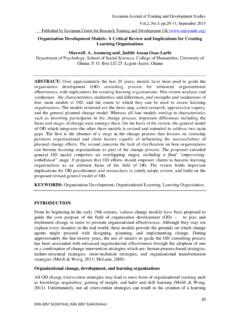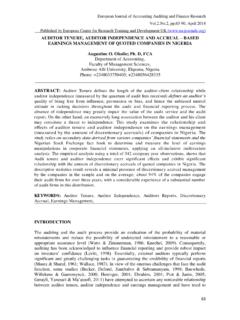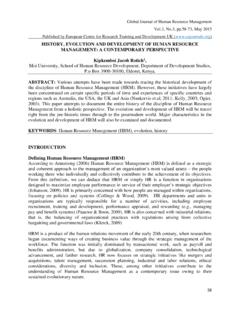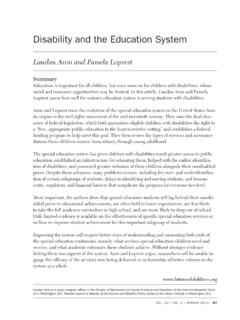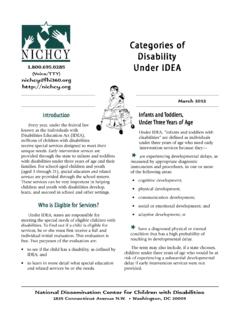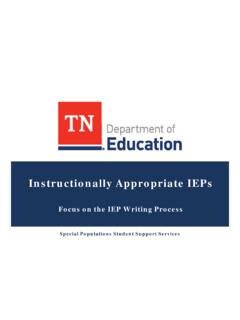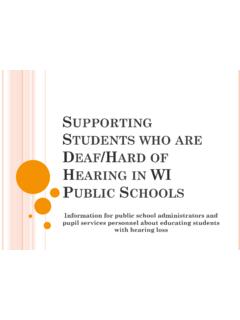Transcription of CHALLENGES FACED BY STUDENTS WITH VISUAL …
1 International Journal of Education, Learning and Development , , , September 2018 ___Published by European Centre for Research Training and Development UK ( ) 38 Print ISSN: ISSN 2054-6297, Online ISSN: ISSN 2054-6300 CHALLENGES FACED BY STUDENTS with VISUAL IMPAIRMENTS WHEN LEARNING PHYSICS IN REGULAR SECONDARY SCHOOLS Alianda Bwire Maindi Physics Teacher, St Benedicts High School-Budalangi, Box 11 Port Victoria, ABSTRACT: The curriculum in regular schools is designed for fully sighted children and is delivered largely through sighted related tasks. The preponderance of visually oriented and visually complex concepts and information in science classrooms poses significant CHALLENGES to learning among visually impaired STUDENTS . Without systematic instructional attention to these CHALLENGES science may seem inaccessible to many STUDENTS with VISUAL impairment, ( Kumar et al 2001).
2 This study investigated the CHALLENGES FACED by STUDENTS with VISUAL impairment when learning physics in regular secondary schools. The intention of the study was to make policy makers to be aware of the difficulties that visually impaired STUDENTS encounter when learning physics in regular secondary schools .The visually impaired STUDENTS would then be supported so that they can overcome these difficulties. This would promote the national special needs educational policy framework which advocates for inclusive education. The objectives of the study was to identify problems visually impaired STUDENTS encounter when learning physics in form two in regular secondary schools .The targeted population in this study was that of form two physics STUDENTS with VISUAL impairment.
3 One hundred and forty seven STUDENTS were selected from regular secondary schools within the study area. A purposive sampling technique was applied to identify the VI STUDENTS within the study location. The location of the study was Busia County, Siaya County, Vihiga County and Kisumu County. The study was guided by the normalization theory. The argument behind it is that a child with whatever kind of disability can live a normal life if given all kind of support just like any other normal child. The data was collected coded and summarized on the basis of objectives of the study. The data was analyzed using SPSS program and reported using frequency distribution tables and percentages. Chi square was used to compare the proportions observed in each category with what would be expected.
4 Test retest technique was used to test the reliability of the research instruments. The study found that classrooms in regular schools lacked adequate light hence are not suitable for accommodation of visually impaired learners. The visually impaired learners were exposed to inappropriate scripts of reading materials and that most of the respondents lacked optical and non-optical devices even though they needed them. The study also found that the visually impaired STUDENTS did not receive support services from the vision support teachers nor interventional measures to help them overcome their VISUAL limitations. The study recommended that Physics teachers adopt an inductive heuristic approach in teaching Physics to visually impaired learners.
5 The study further recommended that teachers trainers should include inclusive education in their curriculum and that Ministry of Education should come up with proper guidelines about inclusive education. At least each regular school should have a department of special needs managed by a special needs teacher. The government through the MOE should also avail funds to regular secondary schools to enable them modify their environments for the purpose of inclusive education. KEYWORDS: VISUAL Impairment, Regular Schools, Inclusive Education International Journal of Education, Learning and Development , , , September 2018 ___Published by European Centre for Research Training and Development UK ( ) 39 Print ISSN: ISSN 2054-6297, Online ISSN: ISSN 2054-6300 INTRODUCTION VISUAL impairment refer to loss of vision even when an individual person wears corrective lens (Agesa , 2014).
6 According to Olmstead (2015), the term VISUAL impairment refers to impairment in vision that even with correction, adversely affects a child s educational performance. Learners with VISUAL impairment can be categorised mainly into two groups according to their educational needs. There are those children who need print as their educational medium and those who need to use Braille , (Verneyen, 2004). However the low vision project groups STUDENTS with VISUAL impairment in five categories. The first category consists of totally blind student. The second group consists of children with vision which is not enough to read print and hence should be educated in (2004) says that the detection of VISUAL problems in children is done by either parents or doctors. However severe eye problems can be detected in hospitals by the eye units.
7 Vision problems can also be detected by tutors in general educational classrooms using behavioural characteristics that may indicate VISUAL function problems. For instance STUDENTS with VISUAL problems may: Usually turn their heads or eye, hold reading materials extremely close to the face or fail to make eye contact when talking to people. The major challenge facing visually impaired STUDENTS in the science educational environment is the overwhelming mass of VISUAL material to which they are continuously exposed to text books, class outlines, class schedules and chalkboard, (Keller et al 2009). The curriculum in regular schools is also designed for fully sighted children and is delivered largely through sight related tasks. If a student has difficulty seeing material at a distance, writing on chalkboards will be hard to discern.
8 The visually impaired can therefore either be provided with optical devices, preferential seating with hand outs containing pertinent information, (Bishop 1996). He also says that curriculum areas such as sciences that require hands on activity and interaction with materials can also present a challenge to STUDENTS with VISUAL impairment. Hence specialized instruments with large numbers as inventive ways of existing materials can help the visually impaired overcome barriers. Optical devices include magnifiers, microscopes, telescopes and lenses. These devices can be used for viewing regular prints materials while some STUDENTS with low vision require their texts to be transcribed into Braille; many are able to access regular or large print.
9 Large print books and papers can be created through modern copy machines even though such copies are often of poor quality. Lengthy texts such as novels might also be presented on audiotapes. However it is recommended that audiotape materials not be stressed until STUDENTS develop the requisite basic literacy skills. The Problem The curriculum in regular schools is designed for fully sighted children and is delivered largely through sight related tasks. Physics is one of the subjects being offered in regular secondary schools. Physics relies a lot on sight and touch in both theory and practical lessons. The visually impaired STUDENTS must overcome many obstacles involving sight if they hope to gain from physics instructions. Yet there is no systematic study that has addressed the problems encountered by these visually impaired STUDENTS in physics classes.
10 There is need therefore to identify academic problems visually impaired STUDENTS encounter when learning physics in regular secondary schools. It is also important to find out the status of support resources and International Journal of Education, Learning and Development , , , September 2018 ___Published by European Centre for Research Training and Development UK ( ) 40 Print ISSN: ISSN 2054-6297, Online ISSN: ISSN 2054-6300 services and their impact on the performances of physics by visually impaired STUDENTS in regular secondary schools. The purpose and objective of the study The study sought to identify the educational problems that visually impaired STUDENTS encounter when learning physics in form two in regular secondary schools, It purposed to highlight the desirable difficulties that visually impaired STUDENTS encounter when learning physics in regular secondary schools.
